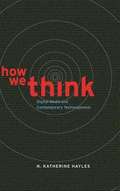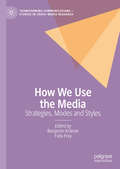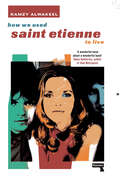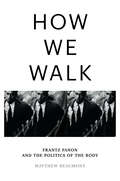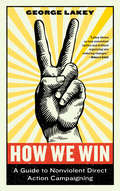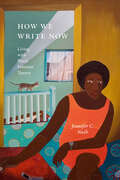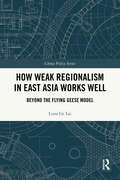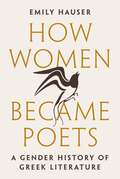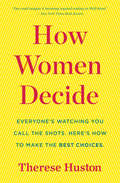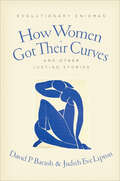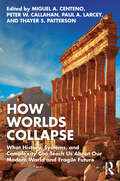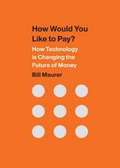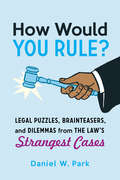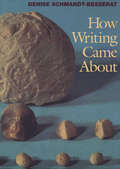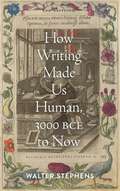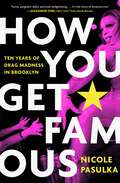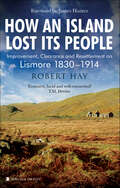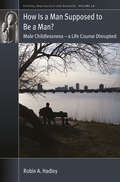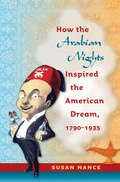- Table View
- List View
How We Think They Think: Anthropological Approaches To Cognition, Memory, And Literacy
by Maurice E BlochThese essays by one of anthropology's most original theorists consider such fundamental questions as: Is cognition language-based? How reliable a guide to memory are people's narratives about themselves? What connects the ?social recalling? studied by anthropologists to the ?autobiographical memory? studied by psychologists? Now gathered in accessible form for the first time and drawing frequently upon the author's fieldwork among the Zafimaniry of Madagascar for ethnographic examples, the twelve closely linked essays of How We Think They Think pose provocative challenges not only to conventional cognitive models but to the basic assumptions that underlie much of ethnography. This book will be read with interest by those who study culture and cognition, ethnographic theory and practice, and the peoples and cultures of Africa.
How We Think: Digital Media and Contemporary Technogenesis
by N. Katherine Hayles"How do we think?" N. Katherine Hayles poses this question at the beginning of this bracing exploration of the idea that we think through, with, and alongside media. As the age of print passes and new technologies appear every day, this proposition has become far more complicated, particularly for the traditionally print-based disciplines in the humanities and qualitative social sciences. With a rift growing between digital scholarship and its print-based counterpart, Hayles argues for contemporary technogenesis--the belief that humans and technics are coevolving--and advocates for what she calls comparative media studies, a new approach to locating digital work within print traditions and vice versa. Hayles examines the evolution of the field from the traditional humanities and how the digital humanities are changing academic scholarship, research, teaching, and publication. She goes on to depict the neurological consequences of working in digital media, where skimming and scanning, or "hyper reading," and analysis through machine algorithms are forms of reading as valid as close reading once was. Hayles contends that we must recognize all three types of reading and understand the limitations and possibilities of each. In addition to illustrating what a comparative media perspective entails, Hayles explores the technogenesis spiral in its full complexity. She considers the effects of early databases such as telegraph code books and confronts our changing perceptions of time and space in the digital age, illustrating this through three innovative digital productions--Steve Tomasula's electronic novel, TOC; Steven Hall's The Raw Shark Texts; and Mark Z. Danielewski's Only Revolutions. Deepening our understanding of the extraordinary transformative powers digital technologies have placed in the hands of humanists, How We Think presents a cogent rationale for tackling the challenges facing the humanities today.
How We Use the Media: Strategies, Modes and Styles (Transforming Communications – Studies in Cross-Media Research)
by Felix Frey Benjamin KrämerThis volume considers strategies, modalities, and styles of media use and reception. Dynamic changes in media technology and infrastructure have spurred important changes in media use. Looking at these developments within the common conceptual framework of reception strategies, modes and styles of media use and reception, this volume is highly relevant against the background of the changing media environment. When it comes to media use and reception, communication research has mainly dealt with two much-cited questions: What do the media do with the people? What do the people do with the media? In comparison, the discipline has devoted less attention to how the media are used, the modalities, patterns or configurations of the actual practices of media use. The volume features original contributions, both empirical and theoretical, on the key concepts and approaches in the field, covering old and new media and different types of media content. Offering a comprehensive overview of existing research as well as promoting original findings and insights, the volume will be of interest to communication researchers, students, and scholars.
How We Used Saint Etienne to Live
by Ramzy AlwakeelThe essential guide to veteran British indie favourites Saint Etienne — the story of how they made music out of memories, and how we made memories out of them.Do you remember how we used to live? British indie favourites Saint Etienne do. But they also remember a load of other stuff that never happened, so maybe they aren&’t the best people to ask.Saint Etienne have spent three decades making music out of memories for people who make memories out of music. How We Used Saint Etienne to Live is the story of that reciprocal process, told in the wrong order but the right time. It&’s about the methods we use to remember, and what happens when those methods become outdated. It&’s a tale that involves tape splicing, town planning, Now compilations and Saint Etienne&’s 1995 UK singles chart peak, &‘He&’s On The Phone&’.Featuring original interviews with Bob Stanley, Pete Wiggs and Sarah Cracknell, How We Used Saint Etienne To Live shows Saint Etienne&’s minds at work as they make and manipulate history and nostalgia. Expect to be shown the receipts. Expect selective recollections and shameless revisionism. Expect concrete facts and flights of fancy. Don&’t expect it to be immediately clear which is which.
How We Walk: Frantz Fanon and the Politics of the Body
by Matthew Beaumont"In this fascinating and wide-ranging book, Beaumont reminds us that walking is far from a neutral activity. With the help of Frantz Fanon, Beaumont locates freedom at the level of the body; free from the systems of oppression, exploitation, and harassment."–Lauren Elkin, author of FlâneuseHow race, class, and politics influence the way we moveYou can tell a lot about people by how they walk. Matthew Beaumont argues that our standing, walking body holds the social traumas of history and its racialized inequalities. Our posture and gait reflect our social and political experiences as we navigate the city under capitalism. Through a series of dialogues with thinkers and walkers, his book explores the relationship between freedom and the human bodyHow We Walk foregrounds the work of Frantz Fanon, psychiatrist and leading thinker of liberation, who was one of the first people to think about the politics of &‘walking while black&’. It also introduces us to the renegade psychoanalyst Wilhelm Reich, who wrote that one could discern the truth about a person through their posture and gait. For Marxist philosopher Ernst Bloch, the ability to walk upright and with ease is a sign of personal and social freedom.Through these excursions, Beaumont reimagines the canonical literature on walking and presents a new interpretation of the impact of class and race on our physical and political mobility, raising important questions about the politics of the body.
How We Win: A Guide to Nonviolent Direct Action Campaigning
by George LakeyA lifetime of activist experience informs this playbook for building and conducting nonviolent direct action campaignsBeginning as a trainer in the civil rights movement of the 1960s, George Lakey has been on the front lines of social change for decades. Now, in this timely and down-to-earth guide, he passes the torch to a new generation of activists hitting the streets. He looks to successful campaigns across the world to help us see what has worked and what hasn’t: from choosing the right target, to designing a creative campaign; from avoiding burnout within your group, to building a movement of movements to achieve real progressive victories. Drawing on the experiences of a diverse set of ambitious change-makers, How We Win shows us the way to justice, peace, and a sustainable economy. This is what democracy looks like.
How We Write Now: Living with Black Feminist Theory (Black Feminism on the Edge)
by Jennifer C. NashIn How We Write Now Jennifer C. Nash examines how Black feminists use beautiful writing to allow writers and readers to stay close to the field’s central object and preoccupation: loss. She demonstrates how contemporary Black feminist writers and theorists such as Jesmyn Ward, Elizabeth Alexander, Christina Sharpe, and Natasha Trethewey mobilize their prose to ask readers to feel, undo, and reassemble themselves. These intimate invitations are more than a set of tools for decoding the social world; Black feminist prose becomes a mode of living and feeling, dreaming and being, and a distinctly affective project that treats loss as not only paradigmatic of Black life but also an aesthetic question. Through her own beautiful writing, Nash shows how Black feminism offers itself as a companion to readers to chart their own lives with and in loss, from devastating personal losses to organizing around the movement for Black lives. Charting her own losses, Nash reminds us that even as Black feminist writers get as close to loss as possible, it remains a slippery object that troubles memory and eludes capture.
How We'll Live On Mars
by Stephen PetranekPart of the TED series: How We'll Live on MarsIt sounds like science fiction, but award-winning journalist Stephen Petranek considers it fact: within 20 years, humans will live on Mars. We'll need to. In this sweeping, provocative book that mixes business, science and human reporting, Petranek makes the case that living on Mars is an essential back-up plan for humanity, and explains in fascinating detail just how it will happen. It's clear that the race is on. Private companies (driven by iconoclastic entrepreneurs like Elon Musk and Sir Richard Branson); Dutch reality show / space mission Mars One; NASA and the Chinese government are among the many groups competing to plant the first stake on Mars and open the door for human habitation. For Elon Musk, it's the "ultimate awesome thing." For other entrepreneurs, it's about competition and opportunity. For NASA, the Chinese government, and the leagues of other private companies and foreign nationals racing to get to Mars, there are more urgent reasons as well: life on Mars has potential life-saving possibilities for those of us on earth. Depleting water supplies, overwhelming climate change and a host of other disasters - from terrorist attacks to meteor strikes - all loom large. We must become a space-faring species to survive. In this close-up narrative chronicle, Petranek introduces the circus of lively characters all engaged in a big-money, big-drama effort to expand the limits of human knowledge - and life - by being the first to settle on the Red Planet. How We'll Live on Mars brings first-hand reporting, interviews with key players and extensive research to bear on the question of how we can best, and most plausibly, expect to see life on Mars - within the next 20 years. Petranek can also be seen discussing his fascinating ideas in his TEDTalk 10 Ways The World Could End.
How Weak Regionalism in East Asia Works Well: Beyond the Flying Geese Model (ISSN)
by Luna Ge LaiThis book investigates the reasons why regionalism in East Asia has been much weaker than in Western Europe and North America. It focuses particularly on economic factors, examining the regional and global linkages of production networks.Through a focused exploration of regional and global production networks, it argues that East Asia was not as regionally concentrated as was Western Europe or North America, lacking a regionally oriented productional basis to support the institutional arrangement of East Asia as a stand-alone economic community. Moreover, the regional production networks of each national economy in the region are influenced by a different set of value-added components from different global and regional origins. This divergence in their positions accounts for the mushrooming of divergent initiatives and projects for regional institutional arrangement. Finally, the institutional choices of the states to join Comprehensive and Progressive Agreement for Trans-Pacific Partnership (CP/TPP) and/or Regional Comprehensive Economic Partnership (RCEP) are found to be strongly influenced by the sectoral focuses and priorities of their economies.Demonstrating how the unique economic factors of each nation override other considerations for greater regional integration, this book will be a valuable resource to students and scholars of international trade, Asian politics and economics.
How Women Became Poets: A Gender History of Greek Literature
by Emily HauserHow the idea of the author was born in the battleground of genderWhen Sappho sang her songs, the only word that existed to describe a poet was a male one—aoidos, or “singer-man.” The most famous woman poet of ancient Greece, whose craft was one of words, had no words with which to talk about who she was and what she did. In How Women Became Poets, Emily Hauser rewrites the story of Greek literature as one of gender, arguing that the ways the Greeks talked about their identity as poets constructed, played with, and broke down gender expectations that literature was for men alone. Bringing together recent studies in ancient authorship, gender, and performativity, Hauser offers a new history of classical literature that redefines the canon as a constant struggle to be heard through, and sometimes despite, gender.Women, as Virginia Woolf recognized, need rooms of their own in order to write. So, too, have women writers through history needed a name to describe what it is they do. Hauser traces the invention of that name in ancient Greece, exploring the archaeology of the gendering of the poet. She follows ancient Greek poets, philosophers, and historians as they developed and debated the vocabulary for authorship on the battleground of gender—building up and reinforcing the word for male poet, then in response creating a language with which to describe women who write. Crucially, Hauser reinserts women into the traditionally all-male canon of Greek literature, arguing for the centrality of their role in shaping ideas around authorship and literary production.
How Women Decide: What's True, What's Not, And Why It Matters
by Therese Huston&“An authoritative guide to help women navigate the workplace and their everyday life with greater success and impact&” (Forbes). So, you&’ve earned a seat at the table. What happens next? We all face hard decisions every day—and the choices we make, and how others perceive them, can be life changing. There are countless books on how to make those tough calls, but How Women Decide is the first to examine a much overlooked truth: Men and women reach verdicts differently, and often in surprising ways. Stress? It makes women more focused. Confidence? Caution can lead to stronger resolutions. And despite popular misconceptions, women are just as decisive as men—though they may pay for it. Pulling from the latest science on decision-making, as well as lively stories of real women and their experiences, cognitive scientist Therese Huston teaches us how we can better shape our habits, perceptions, and strategies, not just to make the most of our own opportunities, but to reform the culture and bring out the best results—regardless of who&’s behind them.
How Women Got Their Curves and Other Just-So Stories: Evolutionary Enigmas
by Judith Eve Lipton David BarashSo how did women get their curves? Why do they have breasts, while other mammals only develop breast tissue while lactating, and why do women menstruate, when virtually no other beings do so? What are the reasons for female orgasm? Why are human females kept in the dark about their own time of ovulation and maximum fertility, and why are they the only animals to experience menopause?David P. Barash and Judith Eve Lipton, coauthors of acclaimed books on human sexuality and gender, discuss the theories scientists have advanced to explain these evolutionary enigmas (sometimes called "Just-So stories" by their detractors) and present hypotheses of their own. Some scientific theories are based on legitimate empirical data, while others are pure speculation. Barash and Lipton distinguish between what is solid and what remains uncertain, skillfully incorporating their expert knowledge of biology, psychology, animal behavior, anthropology, and human sexuality into their entertaining critiques. Inviting readers to examine the evidence and draw their own conclusions, Barash and Lipton tell an evolutionary suspense story that captures the excitement and thrill of true scientific detection.
How Women Got Their Curves and Other Just-So Stories: Evolutionary Enigmas
by Judith Eve Lipton David P BarashThe authors of Gender Gap: The Biology of Male-Female Differences take readers on &“a joyride of intellectual discovery . . . full of provocative ideas&” (Pepper Schwartz, author of Prime). So how did women get their curves? Why do they have breasts, while other mammals only develop breast tissue while lactating, and why do women menstruate, when virtually no other beings do so? What are the reasons for female orgasm? Why are human females kept in the dark about their own time of ovulation and maximum fertility, and why are they the only animals to experience menopause? David P. Barash and Judith Eve Lipton, coauthors of acclaimed books on human sexuality and gender, discuss the theories scientists have advanced to explain these evolutionary enigmas (sometimes called &“Just-So stories&” by their detractors) and present hypotheses of their own. Some scientific theories are based on legitimate empirical data, while others are pure speculation. Barash and Lipton distinguish between what is solid and what remains uncertain, skillfully incorporating their expert knowledge of biology, psychology, animal behavior, anthropology, and human sexuality into their entertaining critiques. Inviting readers to examine the evidence and draw their own conclusions, Barash and Lipton tell an evolutionary suspense story that captures the excitement and thrill of true scientific detection. &“A delightful, thought-provoking volume on perennial questions about female biology . . . Along the way, they present a large amount of accessible information about biology, psychology, physiology and anatomy. Even more important, they demonstrate how scientists work to create and assess hypotheses while having a great deal of fun.&”—Publishers Weekly
How Worlds Collapse: What History, Systems, and Complexity Can Teach Us About Our Modern World and Fragile Future
by Miguel A. Centeno, Peter W. Callahan, Paul A. Larcey, Thayer S. PattersonAs our society confronts the impacts of globalization and global systemic risks—such as financial contagion, climate change, and epidemics—what can studies of the past tell us about our present and future? How Worlds Collapse offers case studies of societies that either collapsed or overcame cataclysmic adversity. The authors in this volume find commonalities between past civilizations and our current society, tracing patterns, strategies, and early warning signs that can inform decision-making today. While today’s world presents unique challenges, many mechanisms, dynamics, and fundamental challenges to the foundations of civilization have been consistent throughout history—highlighting essential lessons for the future.
How Would You Like to Pay?: How Technology Is Changing the Future of Money
by Bill MaurerFrom Bitcoin to Apple Pay, big changes seem to be afoot in the world of money. Yet the use of coins and paper bills has persisted for 3,000 years. In How Would You Like to Pay?, leading anthropologist Bill Maurer narrates money's history, considers its role in everyday life, and discusses the implications of how new technologies are changing how we pay. These changes are especially important in the developing world, where people who lack access to banks are using cell phones in creative ways to send and save money. To truly understand money, Maurer explains, is to understand and appreciate the complex infrastructures and social relationships it relies on. Engaging and straightforward, How Would You Like to Pay? rethinks something so familiar and fundamental in new and exciting ways. Ultimately, considering how we would like to pay gives insights into determining how we would like to live.
How Would You Rule?: Legal Puzzles, Brainteasers, and Dilemmas from the Law's Strangest Cases
by Daniel W. ParkHow Would You Rule is a lighthearted introduction to fundamental concepts of law through strange but true legal cases. Each chapter tells the story of a different case and presents the main arguments of the opposing parties. The twist? Before the ruling of the court is revealed, readers are challenged to put themselves in the shoes--or the robes--of the judges and decide for themselves how they would rule in these cases. After coming up with their own solutions, readers can learn how the actual judges resolved the disputes. The goal is to get readers to think for themselves about what's right and what's wrong, sharpening their own instincts for the reasons and analyses that win arguments.
How Writing Came About
by Denise Schmandt-BesseratIn 1992, the University of Texas Press published Before Writing, Volume I: From Counting to Cuneiform and Before Writing, Volume II: A Catalog of Near Eastern Tokens. In these two volumes, Denise Schmandt-Besserat set forth her groundbreaking theory that the cuneiform script invented in the Near East in the late fourth millennium B. C. -the world's oldest known system of writing-derived from an archaic counting device. How Writing Came About draws material from both volumes to present Schmandt-Besserat's theory for a wide public and classroom audience. Based on the analysis and interpretation of a selection of 8,000 tokens or counters from 116 sites in Iran, Iraq, the Levant, and Turkey, it documents the immediate precursor of the cuneiform script.
How Writing Came About
by Denise Schmandt-BesseratAn &“utterly lucid, thoughtfully illustrated, and thoroughly convincing&” book on the origins of the world&’s oldest known system of writing (American Journal of Archaeology). One of American Scientist&’s Top 100 Books on Science, 2001 In 1992, the University of Texas Press published Before Writing, Volume I: From Counting to Cuneiform and Before Writing, Volume II: A Catalog of Near Eastern Tokens. In these two volumes, Denise Schmandt-Besserat set forth her groundbreaking theory that the cuneiform script invented in the Near East in the late fourth millennium B.C.—the world's oldest known system of writing—derived from an archaic counting device. How Writing Came About draws material from both volumes of this scholarly work to present Schmandt-Besserat&’s theory in an abridged version for a wide public and classroom audience. Based on the analysis and interpretation of a selection of 8,000 tokens or counters from 116 sites in Iran, Iraq, the Levant, and Turkey, it documents the immediate precursor of the cuneiform script.
How You Get Famous: Ten Years of Drag Madness in Brooklyn
by Nicole PasulkaA madcap adventure through a tight-knit world of drag performers making art and mayhem in the greatest city on earth.Ten years ago, an aimless coat check girl better known today as Merrie Cherry sweet-talked her boss into giving her $100 to host a drag show at a Brooklyn dive bar. Soon, kids like Aja were kicking their way into the scene, sneaking into clubs, pocketing their tips to help mom pay the mortgage, and sharing the stage with electric performers like Thorgy Thor and Sasha Velour. Because suddenly, in the biggest, brightest city in America, drag was offering young, broke, creative queer people a chance at real money—and for thousands or even millions of people to learn their names. In How You Get Famous, journalist Nicole Pasulka joyfully documents the rebirth of the New York drag scene, following a group of iconoclastic performers with undeniable charisma, talent, and a hell of a lot to prove. The result is a sweeping portrait of the 21st-century search for celebrity and community, as well as a chronicle of all the struggles, fights, and disappointments along the way. A rollicking account of the quest to make a living through an art form on the cusp of becoming a cultural phenomenon, How You Get Famous offers an unmissable romp through the gritty and glamorous world of Brooklyn drag.
How a Mountain Was Made: Stories
by Greg SarrisIn the tradition of Calvino's Italian Folktales, Greg Sarris, author of the award-winning novel Grand Avenue, turns his attention to his ancestral homeland of Sonoma Mountain in Northern California. In sixteen interconnected original stories, the twin crows Question Woman and Answer Woman take us through a world unlike yet oddly reminiscent of our own: one which blooms bright with poppies, lupines, and clover; one in which Waterbug kidnaps an entire creek; in which songs have the power to enchant; in which Rain is a beautiful woman who keeps people's memories in stones. Inspired by traditional Coast Miwok and Southern Pomo creation tales, these stories are timeless in their wisdom and beauty, and because of this timelessness their messages are vital and immediate. The figures in these stories ponder the meaning of leadership, of their place within the landscape and their community. In these stories we find a model for how we can all come home again. At once ancient and contemporary, How a Mountain Was Made is equally at home in modern letters as the ancient story cycle. Sarris infuses his stories with a prose stylist's creativity and inventiveness, moving American Indian literature in a new and emergent direction.
How an Island Lost Its People: Improvement, Clearance and Resettlement on Lismore 1830–1914
by Robert HayIn 1830, the little Hebridean island of Lismore was one of the granaries of the West Highlands, with every possible scrap of land producing bere barley or oats. The population had reached its peak of 1500, but by 1910, numbers had dwindled to 400 and were still falling. The agricultural economy had been almost completely transformed to support sheep and cattle, with ploughland replaced by the now familiar green grassy landscape. With reference to documentary sources, including Poor Law reports, the report of the Napier Commission into the condition crofters in the Highlands and Islands, as well as local documents and letters, this book documents a century of emigration, migration and clearance and paints an intimate portrait of the island community during a period of profound change. At the same time, it also celebrates the achievements of the many tenants who grasped the opportunities involved in agricultural improvement.
How is a Man Supposed to be a Man?: Male Childlessness – a Life Course Disrupted (Fertility, Reproduction and Sexuality: Social and Cultural Perspectives #48)
by Robin A HadleyThe global trend of declining fertility rates and an increasingly ageing population has serious implications for individuals and institutions alike. Childless men are mostly excluded from ageing, social science and reproduction scholarship and almost completely absent from most national statistics. This unique book examines the lived experiences of a hidden and disenfranchised population: men who wanted to be fathers. It explores the complex intersections that influence childlessness over the life course.
How is a Man Supposed to be a Man?: Male Childlessness – a Life Course Disrupted (Fertility, Reproduction and Sexuality: Social and Cultural Perspectives #48)
by Robin A HadleyThe global trend of declining fertility rates and an increasingly ageing population has serious implications for individuals and institutions alike. Childless men are mostly excluded from ageing, social science and reproduction scholarship and almost completely absent from most national statistics. This unique book examines the lived experiences of a hidden and disenfranchised population: men who wanted to be fathers. It explores the complex intersections that influence childlessness over the life course.
How the Arabian Nights Inspired the American Dream, 1790-1935
by Susan NanceAmericans have always shown a fascination with the people, customs, and legends of the "East"--witness the popularity of the stories of theArabian Nights, the performances of Arab belly dancers and acrobats, the feats of turban-wearing vaudeville magicians, and even the antics of fez-topped Shriners. In this captivating volume, Susan Nance provides a social and cultural history of this highly popular genre of Easternized performance in America up to the Great Depression. According to Nance, these traditions reveal how a broad spectrum of Americans, including recent immigrants and impersonators, behaved as producers and consumers in a rapidly developing capitalist economy. In admiration of theArabian Nights, people creatively reenacted Eastern life, but these performances were also demonstrations of Americans' own identities, Nance argues. The story of Aladdin, made suddenly rich by rubbing an old lamp, stood as a particularly apt metaphor for how consumer capitalism might benefit each person. The leisure, abundance, and contentment that many imagined were typical of Eastern life were the same characteristics used to define "the American dream. " The recent success of Disney'sAladdinmovies suggests that many Americans still welcome an interpretation of the East as a site of incredible riches, romance, and happy endings. This abundantly illustrated account is the first by a historian to explain why and how so many Americans sought out such cultural engagement with the Eastern world long before geopolitical concerns became paramount.

